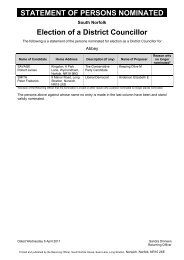Local Plan Part 1 Section 3: Leisure [PDF, 78k] - South Norfolk Council
Local Plan Part 1 Section 3: Leisure [PDF, 78k] - South Norfolk Council
Local Plan Part 1 Section 3: Leisure [PDF, 78k] - South Norfolk Council
Create successful ePaper yourself
Turn your PDF publications into a flip-book with our unique Google optimized e-Paper software.
<strong>South</strong> <strong>Norfolk</strong> <strong>Local</strong> <strong>Plan</strong> Adopted Version (March 2003)<br />
<strong>Part</strong> One <strong>Section</strong> 3 - <strong>Leisure</strong><br />
SECTION 3<br />
LEISURE<br />
1. Introduction<br />
2. <strong>Leisure</strong> and recreation: general<br />
a) Extensive and noisy leisure uses<br />
b) Village halls and small scale leisure facilities in villages<br />
c) Monitoring of demand<br />
d) Major indoor leisure facilities<br />
e) Other leisure facilities<br />
3. Outdoor recreation<br />
a) Recreational open space<br />
b) Informal countryside recreation<br />
c) Water based recreation<br />
d) Costessey pits<br />
e) Bawburgh/Colney gravel pits<br />
f) Royal <strong>Norfolk</strong> Showground<br />
g) Horses kept for recreational use<br />
<strong>South</strong> <strong>Norfolk</strong> <strong>Council</strong> <strong>Plan</strong>ning Services Page 105
<strong>South</strong> <strong>Norfolk</strong> <strong>Local</strong> <strong>Plan</strong> Adopted Version (March 2003)<br />
<strong>Part</strong> One <strong>Section</strong> 3 - <strong>Leisure</strong><br />
<strong>South</strong> <strong>Norfolk</strong> <strong>Council</strong> <strong>Plan</strong>ning Services Page 106
<strong>South</strong> <strong>Norfolk</strong> <strong>Local</strong> <strong>Plan</strong> Adopted Version (March 2003)<br />
<strong>Part</strong> One <strong>Section</strong> 3 - <strong>Leisure</strong><br />
SECTION 3<br />
LEISURE<br />
1. Introduction<br />
The term ‘leisure’ used in this <strong>Plan</strong> encompasses a range of leisure activities and facilities<br />
including sport and recreation, the arts (including visual and performing arts and community<br />
based arts activities), and countryside recreation. Pressure for the use of land for leisure<br />
purposes exists not only from residents within the District but also people living beyond,<br />
especially in Norwich. Pressure is increasing on existing facilities and for the provision of new<br />
facilities both at a local level and also to serve a wider population. Opportunities exist within<br />
and adjacent to the <strong>Plan</strong> Area to develop facilities at both a local and sub-regional level. In<br />
certain cases this will require working in partnership with other Districts. The <strong>Council</strong>’s 1998<br />
<strong>Leisure</strong> Strategy is an important context for this section of the <strong>Plan</strong>.<br />
The demand for recreation and leisure facilities is likely to continue to increase during the <strong>Plan</strong><br />
period due to:<br />
• The increase in the number of people living within the District.<br />
• The anticipated increase in leisure time available.<br />
• The promotion and development of the facilities available.<br />
• Improved accessibility for people living outside <strong>South</strong> <strong>Norfolk</strong>.<br />
• Availability of lottery funding.<br />
• The increase in disposable income levels.<br />
Proposals for the use of land for leisure purposes are also likely to increase due to the<br />
pressures for agricultural diversification.<br />
Currently the <strong>Plan</strong> Area offers a range of leisure facilities such as sports halls, squash courts,<br />
golf courses and swimming pools, as well as village halls and community facilities at a more<br />
local level. There are also opportunities for quieter leisure pursuits on a limited number of small<br />
countryside sites - picnic areas, commons, footpath network etc.<br />
The major centre for large-scale commercial leisure facilities, such as multiplex cinemas and the<br />
associated complexes of restaurants and bars, is Norwich. Smaller scale indoor leisure facilities<br />
such as theatres and galleries, as well as indoor sports facilities such as bowling alleys, may<br />
come forward within <strong>South</strong> <strong>Norfolk</strong>. A specific leisure allocation is made in Diss as part of policy<br />
DIS 6.<br />
The District <strong>Council</strong> is a provider and enabler of leisure opportunities and is involved in a<br />
number of activities including:<br />
• The promotion and development of sport and leisure.<br />
• The <strong>South</strong> <strong>Norfolk</strong> <strong>Leisure</strong> Strategy, which addresses the issue of increasing<br />
pressure for facilities.<br />
• Action to identify and rectify deficiencies in facilities while seeking to either directly<br />
provide them or do so in conjunction with other interests.<br />
• Financial assistance to Parish <strong>Council</strong>s and the voluntary sector through grant aid,<br />
either directly or by assisting Parish <strong>Council</strong>s in securing alternative sources of<br />
funding.<br />
<strong>South</strong> <strong>Norfolk</strong> <strong>Council</strong> <strong>Plan</strong>ning Services Page 107
<strong>South</strong> <strong>Norfolk</strong> <strong>Local</strong> <strong>Plan</strong> Adopted Version (March 2003)<br />
<strong>Part</strong> One <strong>Section</strong> 3 - <strong>Leisure</strong><br />
2. <strong>Leisure</strong> and recreation: general<br />
The District <strong>Council</strong> has sought to encourage the development of local leisure facilities through<br />
its leisure grant aid policies. Such grants, subject to limited resources, can be made available to<br />
clubs and organisations in the <strong>Plan</strong> Area. Town and Parish <strong>Council</strong>s also play an important role<br />
in providing and financing local facilities in association with leisure grant aid.<br />
As the introduction states, there is increasing demand for leisure and recreation facilities for a<br />
variety of reasons. Demand may also arise as a result of large residential allocations and<br />
windfall sites, policy UTL 10 and the policies for individual housing allocations in <strong>Part</strong> Two of this<br />
<strong>Plan</strong> expect developers to contribute to the cost of identified new facilities.<br />
a) Extensive and noisy leisure uses<br />
The extent to which the demand for new leisure and recreation facilities in the District can be<br />
met will be closely related to environmental concerns, ranging from broader landscape<br />
considerations to more local factors such as traffic generation.<br />
Policy LEI 1: Extensive and noisy leisure uses<br />
Proposals for golf courses, country parks and other leisure uses which require<br />
extensive areas of land, and proposals for noisy leisure activities such as<br />
shooting, motor sports and motorised water sports will be permitted if:<br />
a) There would be no harm to the value of the environmental characteristics<br />
and resources of the site and its surroundings;<br />
b) Harm would not be caused by the nature, scale, extent, frequency or timing<br />
of the leisure activities proposed, including:<br />
i) Any noise likely to be generated by the proposed activities;<br />
ii) The appearance of any building or structure required for the<br />
activity;<br />
iii) Any lighting likely to be required which could have an impact<br />
beyond the site;<br />
iv) The number of people likely to be at the site at any one time and<br />
their degree of concentration or dispersal within the site;<br />
c) Harm would not be caused by the landforming works proposed including the<br />
formation of playing surfaces, construction of car parking, terracing,<br />
mounding and the planting of trees;<br />
d) The proposal would be accessible by public transport, by bicycle or on foot;<br />
e) The local road network could handle safely the extra traffic the proposal<br />
would generate and the road access and exit at the site would be safe;<br />
f) In the case of major facilities the <strong>Council</strong>’s leisure strategy or the<br />
developer’s own research identifies a need for the facility within the District.<br />
<strong>South</strong> <strong>Norfolk</strong> <strong>Council</strong> <strong>Plan</strong>ning Services Page 108
<strong>South</strong> <strong>Norfolk</strong> <strong>Local</strong> <strong>Plan</strong> Adopted Version (March 2003)<br />
<strong>Part</strong> One <strong>Section</strong> 3 - <strong>Leisure</strong><br />
In relation to environmental characteristics, the evaluation of any proposal will take account of<br />
the existence of designations such as Conservation Areas, Nature Reserves and environmental<br />
assets as covered by policies in the ‘Protection of Environmental Assets’ and the ‘Controlling<br />
the Impact of Development’ chapters of this <strong>Plan</strong>. The <strong>Council</strong> would expect developments<br />
such as golf courses to be successfully integrated into the landscape, respecting the existing<br />
landscape character and enhancing the biodiversity of the area. In the case of developments<br />
such as shooting and motorsports these should be located with special regard for their<br />
separation from dwellings, livestock holdings and areas of quiet countryside. These uses would<br />
often be suited to former gravel workings or other similar areas of degraded landscape rather<br />
than greenfield sites in open countryside.<br />
b) Village halls and small scale leisure facilities in villages<br />
Policy LEI 2: Village halls and small scale leisure facilities<br />
Proposals for new village halls, extensions to existing village halls and similar<br />
small-scale leisure facilities intended to serve the local community will be<br />
permitted if:<br />
a) There would be no harm to the value of the environmental characteristics<br />
and resources of the site and its surroundings;<br />
b) Harm would not be caused by the nature, scale, extent, frequency or timing<br />
of the leisure activities proposed, including;<br />
i) Any noise likely to be generated by the proposed activities;<br />
ii) The appearance of any building or structure required for the<br />
activity;<br />
iii) Any lighting likely to be required which could have an impact<br />
beyond the site;<br />
iv) The number of people likely to be at the site at any one time and<br />
their degree of concentration or dispersal within the site;<br />
c) The proposal would be accessible by public transport, by bicycle or on foot;<br />
d) The local road network could handle safely the extra traffic the proposal<br />
would generate and the road access and exit at the site would be safe;<br />
e) The building is within or adjacent to the existing built up area such that<br />
development does not extend out into open countryside<br />
f) The development is located so as not to cause nuisance to residents of<br />
neighbouring properties.<br />
The <strong>Council</strong> wishes to encourage new leisure and community facilities in villages to meet the<br />
needs of the local population. However it is important that these facilities do not damage the<br />
character or landscape setting of the villages and that they do not create noise or similar<br />
problems for nearby residents. Proposals should therefore clearly indicate the range of uses<br />
proposed, the provision of sound attenuation measures and the intended hours of use of the<br />
building.<br />
With regard to the environmental characteristics and resources referred to in part a) of policies<br />
LEI 1 and LEI 2, further information is given in the last paragraph of section d) below.<br />
Reference should also be made to policy IMP 25 which deals with light pollution in the<br />
countryside as there are minimum floodlight requirements for various sports, set by the Sports<br />
<strong>Council</strong><br />
<strong>South</strong> <strong>Norfolk</strong> <strong>Council</strong> <strong>Plan</strong>ning Services Page 109
<strong>South</strong> <strong>Norfolk</strong> <strong>Local</strong> <strong>Plan</strong> Adopted Version (March 2003)<br />
<strong>Part</strong> One <strong>Section</strong> 3 - <strong>Leisure</strong><br />
c) Monitoring of demand<br />
It is important to ensure that there is adequate leisure and recreational land available to meet<br />
the needs and demands of the local population and the District <strong>Council</strong> will therefore monitor the<br />
demand for such land.<br />
Policy LEI 3: Shortfalls of leisure and recreational land<br />
The District <strong>Council</strong> will, in conjunction with local users, monitor the demand for<br />
additional leisure and recreational land. If further shortages become evident<br />
appropriate remedial action will be investigated and if necessary suitable sites<br />
will be identified to rectify any shortfalls.<br />
Attention: Please note that <strong>Local</strong> <strong>Plan</strong> policy LEI 3 has been discontinued<br />
since 28 th September 2007 as part of the ‘saved policy’ process. Applicants<br />
should now instead refer to national planning policy guidance PPG17 (Sport and<br />
Recreation).<br />
d) Major indoor leisure facilities<br />
Regional sports bodies and the District <strong>Council</strong> <strong>Leisure</strong> Strategy have identified deficiencies in<br />
indoor leisure facilities in <strong>South</strong> <strong>Norfolk</strong>, including sports halls, swimming pools and arts centres.<br />
These can be provided by the private sector or through public sector assistance via grant aid,<br />
lottery funding or as a result of direct provision. The District <strong>Council</strong> would wish to see major<br />
new indoor facilities provided within or adjacent to town centres, in order to improve the vitality<br />
and viability of town centres in line with <strong>Plan</strong>ning Policy Guidance Note (PPG) 6 “Town Centres<br />
and Retail Development” (June 1996) and in order to reduce unnecessary travelling in line with<br />
<strong>Plan</strong>ning Policy Guidance Note (PPG) 13 “Transport” (March 2001). In accordance with the<br />
Government’s sequential approach, it is anticipated that facilities of regional or sub-regional<br />
significance will be located in Norwich or Great Yarmouth.<br />
Policy LEI 4: Indoor leisure facilities - sequential test<br />
<strong>Plan</strong>ning permission for new indoor leisure facilities, and for the extension of<br />
existing facilities, will be granted within the Central Business Areas of the<br />
District’s main towns and villages, as defined on the Proposals Map, subject to<br />
the provisions of policy LEI 5.<br />
If suitable sites cannot be found within the defined Central Business Areas,<br />
consideration will be given to edge-of-centre locations where pedestrian access<br />
to and from the centre is easy and attractive.<br />
Only where no suitable Central Business Area site or edge-of-centre site is<br />
available, will consideration be given to out-of-centre locations.<br />
(Continued…)<br />
<strong>South</strong> <strong>Norfolk</strong> <strong>Council</strong> <strong>Plan</strong>ning Services Page 110
<strong>South</strong> <strong>Norfolk</strong> <strong>Local</strong> <strong>Plan</strong> Adopted Version (March 2003)<br />
<strong>Part</strong> One <strong>Section</strong> 3 - <strong>Leisure</strong><br />
(Policy LEI 4 continued)<br />
In out-of-centre locations, the following criteria must also be satisfied:<br />
i) The site is not designated for an alternative use; and<br />
ii) The site is easily accessible by pedestrians, cyclists and public transport<br />
from the surrounding catchment area; and<br />
iii) The site is close enough to other tourism, leisure, employment or retail<br />
facilities to encourage linked trips; and<br />
iv) The proposals would result in a net reduction in total private motor vehicle<br />
trip length.<br />
Policy LEI 5: Indoor leisure facilities - impact test<br />
Indoor leisure facilities on sites within the Central Business Areas, as identified<br />
on the Proposals Map, of the District’s main towns and villages, or on edge-ofcentre<br />
sites, or on out-of-centre sites will only be permitted if the nature and scale<br />
of the proposed development would be in keeping with the size and function of<br />
the settlement concerned, and there would be no demonstrable harm (either<br />
individually or cumulatively with other proposed development) to:<br />
i) The vitality and viability of the identified Central Business Areas; and<br />
ii) Proposals to enhance these Central Business Areas or their fringes; and<br />
iii) The quality of the local environment; and<br />
iv) The highway and transportation network.<br />
In the preceding two policies the term ‘Indoor leisure facilities’ means leisure facilities provided<br />
within a building with the primary purpose of meeting the leisure needs of the resident<br />
population of the area.<br />
Whilst the <strong>Council</strong> wishes to encourage additional leisure provision in the area, this will not be at<br />
the expense of the quality and attractiveness of the local landscape. The <strong>Plan</strong> contains policies<br />
(ENV 1, 2, 3, 4, 5 and 6), which seek to protect the character and distinctiveness of the <strong>South</strong><br />
<strong>Norfolk</strong> landscape. In the Norwich Policy Area these policies would prevent “inappropriate<br />
development” (see glossary) in the defined river valleys, historic parklands, gaps between<br />
settlements and in the landscape setting of the Norwich <strong>South</strong>ern Bypass. This would restrict<br />
the creation of some new leisure facilities in these areas. Proposals for leisure development will<br />
also need to ensure there is no conflict with other policies in the ‘Protection of Environmental<br />
Assets’ and the ‘Controlling the Impact of Development’ chapters, which seek to achieve<br />
protection of the District’s environmental assets.<br />
e) Other leisure facilities<br />
Policy LEI 6: Smaller scale leisure facilities<br />
Smaller scale facilities will be encouraged to locate within District or local centres<br />
where they are well related to and readily accessible to the population they are<br />
intended to serve.<br />
Opportunities may arise for the conversion of redundant industrial, commercial, educational or<br />
agricultural buildings for leisure purposes. Such schemes are considered to be commercial<br />
<strong>South</strong> <strong>Norfolk</strong> <strong>Council</strong> <strong>Plan</strong>ning Services Page 111
<strong>South</strong> <strong>Norfolk</strong> <strong>Local</strong> <strong>Plan</strong> Adopted Version (March 2003)<br />
<strong>Part</strong> One <strong>Section</strong> 3 - <strong>Leisure</strong><br />
uses which fall within the scope of policy EMP 3 and will be permitted if the criteria contained in<br />
that policy are met.<br />
3. Outdoor recreation<br />
a) Recreational open space<br />
The <strong>Council</strong>’s current open space standards are based on extrapolation of the National Playing<br />
Fields Association (NPFA) ‘6 acre standard’ which indicates a general requirement of 2.4 ha. of<br />
open space per 1,000 people. The <strong>Council</strong> intend to identify deficiencies in public open space<br />
and recreation provision, and justify the amount and location of new provision, in the next review<br />
of the <strong>Plan</strong>.<br />
The <strong>Council</strong>’s Supplementary <strong>Plan</strong>ning Guidance ‘Recreational Open Space Requirements for<br />
Residential Areas’ (December 1994), copies of which may be obtained from the <strong>Council</strong>’s<br />
<strong>Plan</strong>ning Services, sets out the standards which will be required for open space in new<br />
developments and acceptable arrangements for its maintenance. The location of open space<br />
areas will require careful siting so that they are accessible to users whilst avoiding the creation<br />
of nuisance and disturbance to residents.<br />
Policy LEI 7: Open space provision in new development<br />
New housing development will be required to incorporate private and public open<br />
space areas based on the District <strong>Council</strong>’s adopted standards.<br />
The <strong>Council</strong>’s Recreational Open Space Guidelines set out the provisions regarding<br />
responsibility for maintenance in some detail. Contribution will be sought from the developer<br />
towards future maintenance as appropriate.<br />
Larger housing and employment allocations in this <strong>Plan</strong> will not only require the provision of<br />
public open space (in the case of housing areas) and landscaping within the site, but also<br />
require sizeable landscaped areas between these allocations and open countryside; see policy<br />
IMP 2 and <strong>Part</strong> Two policies.<br />
The <strong>Council</strong> is anxious that existing open spaces which meet a local need are retained. The<br />
Town and Country <strong>Plan</strong>ning (General Development Procedure) (Amendment) Order (1996)<br />
requires consultation with Sport England on any proposal affecting land used as a playing field.<br />
Circular 9/98, The Town and Country <strong>Plan</strong>ning (Playing Fields) (England) Direction 1998<br />
provides specific advice to notify the relevant Government Office where the <strong>Council</strong> is minded to<br />
approve an application on which Sport England have objected; this relates specifically to local<br />
authority sites or those used in conjunction with an educational establishment within the five<br />
years prior to the application.<br />
<strong>South</strong> <strong>Norfolk</strong> <strong>Council</strong> <strong>Plan</strong>ning Services Page 112
<strong>South</strong> <strong>Norfolk</strong> <strong>Local</strong> <strong>Plan</strong> Adopted Version (March 2003)<br />
<strong>Part</strong> One <strong>Section</strong> 3 - <strong>Leisure</strong><br />
Policy LEI 8: Loss of recreational or amenity land<br />
The change of use or redevelopment of existing recreation or amenity land will<br />
only be permitted where:<br />
i) The proposed development is ancillary to the principal recreational use of<br />
the site;<br />
ii) It affects only a small part of the site and does not prejudice sporting or<br />
other recreational facilities on the site;<br />
iii) It involves the replacement of the recreational facilities with another of<br />
equivalent or improved quality;<br />
iv) An assessment of needs shows there is an excess of provision of the facility<br />
and it cannot be adapted to meet other recreational needs;<br />
v) It is part of the relocation of a sports (or similar) club which will provide an<br />
overall improvement in recreational facilities;<br />
vi) It will result in recreational provisions better suited to future needs and there<br />
is no current shortage of playing fields or recreational/amenity land in the<br />
locality.<br />
School playing fields offer potential for public recreational use, especially in areas where there<br />
are deficiencies in open space provision. Consequently the <strong>Council</strong> encourages dual use of<br />
such facilities.<br />
Policy LEI 9: Joint provision and dual use of recreation facilities<br />
The District <strong>Council</strong> will encourage joint provision recreation schemes on school<br />
sites and the dual use of recreation facilities on school sites.<br />
As well as applying to the public use of outdoor facilities the above policy can also apply to the<br />
public use of school buildings. Joint provision schemes between the education authority,<br />
schools and the District <strong>Council</strong> can help to provide local outdoor and indoor facilities.<br />
Appropriate Town or Parish <strong>Council</strong>s will be asked to assume ownership of and accept<br />
responsibility for the maintenance (arising after the period covered by any lump sum<br />
arrangements) of playing fields, children’s play areas and equipment provided. Where these<br />
are not accepted, the District <strong>Council</strong> will reach agreement with the developer over future<br />
ownership and maintenance responsibility.<br />
b) Informal countryside recreation<br />
As previously stated, a limited number of sites exist for quieter informal countryside recreation.<br />
Of the more significant schemes are the Angles Way footpath, which runs along much of the<br />
Waveney Valley, the Tas Valley Walk, Boudicas Way and the Marriotts Way at Costessey. At a<br />
more local level are Commons (Mulbarton Common, Swardeston Common, Hales Green,<br />
Roydon Fen; and Dunston Common (which although not a registered common is amenity land<br />
for public use), and heathland (for example Broome Heath), as well as many other areas with<br />
public access.<br />
<strong>South</strong> <strong>Norfolk</strong> <strong>Council</strong> <strong>Plan</strong>ning Services Page 113
<strong>South</strong> <strong>Norfolk</strong> <strong>Local</strong> <strong>Plan</strong> Adopted Version (March 2003)<br />
<strong>Part</strong> One <strong>Section</strong> 3 - <strong>Leisure</strong><br />
The District <strong>Council</strong> has entered into partnership with other local authorities to form countryside<br />
management projects (see policy ENV 22). The Upper Waveney Valley Countryside Project<br />
covers parishes along the Waveney Valley on the southern boundary of the <strong>Plan</strong> Area. The<br />
Wensum Valley Project stretches from beyond Fakenham in North <strong>Norfolk</strong> to Norwich, and<br />
includes Costessey and part of Easton. The Norwich Urban Fringe Project includes most of the<br />
Yare Valley lying within the <strong>Plan</strong> Area and part of the Tas Valley. One of the main aims of all<br />
these projects is to improve public access to the countryside for active and passive recreational<br />
pursuits (including walking and cycling), yet at the same time safeguarding areas of nature<br />
conservation value.<br />
Policy LEI 10: Public access through countryside projects<br />
The District <strong>Council</strong> supports the aims of the Upper Waveney Valley countryside<br />
management project, the Wensum Valley project, and the Norwich Fringe project<br />
to increase/improve opportunities for public access/recreation in the <strong>Plan</strong> Area.<br />
The <strong>Plan</strong> Area offers an attractive environment for cycling and with the increasing interest in this<br />
as a recreational pursuit the District <strong>Council</strong> wishes to improve conditions for cyclists by the<br />
introduction of cycle routes (see policy TRA 2) and cycle facilities (see policy TRA 3). The<br />
District <strong>Council</strong> has published a series of cycle route leaflets and with the Upper Waveney<br />
Valley Countryside Project has identified suitable cycle routes within the Waveney Valley. It is<br />
important that increasing public access is consistent with nature conservation and landscape<br />
objectives and policies.<br />
The <strong>Council</strong> has also considered its potential for achieving the aims of the National Cycling<br />
Strategy (which include doubling the number of cycle trips 1996-2002 and again by 2012) and<br />
produced a draft cycling strategy in 2003. The <strong>South</strong> <strong>Norfolk</strong> Cycling Forum, which is an<br />
independent body, aims among other things to encourage the County <strong>Council</strong> to spend some of<br />
its budget on cycling (including leisure use) routes in the District and also advises the District<br />
<strong>Council</strong> on the production its own leisure cycle route leaflets.<br />
c) Water based recreation<br />
The <strong>Council</strong> wishes to encourage recreational use of areas of water in the <strong>Plan</strong> Area, both to<br />
increase the range and accessibility of recreational facilities and to help ease the pressure on<br />
some of the more popular and sensitive Broads locations. However, it must be recognised that<br />
most water bodies within the <strong>Plan</strong> Area are themselves environmentally sensitive and/or lie<br />
within areas of sensitive landscape and/or areas of nature conservation value. Policy LEI 11<br />
therefore contains a number of criteria designed to ensure that proposals do not harm the<br />
environment. In assessing the impact of a proposal, account will be taken of the sensitivity of<br />
the landscape as indicated in the <strong>South</strong> <strong>Norfolk</strong> Landscape Character Assessment as well as of<br />
Conservation Areas and the other environmental assets for which this <strong>Plan</strong> provides protective<br />
policies.<br />
In terms of nature conservation value, account will be taken of the existing value of the site as<br />
indicated by any local, national or international designations and by surveys, as well as any<br />
contribution the development may make to increasing biodiversity. Proposals will also need to<br />
demonstrate no adverse impact on water quality and recognise that water levels can change<br />
naturally and that any input of water to maintain levels for the recreational use will have to be<br />
licensed.<br />
<strong>South</strong> <strong>Norfolk</strong> <strong>Council</strong> <strong>Plan</strong>ning Services Page 114
<strong>South</strong> <strong>Norfolk</strong> <strong>Local</strong> <strong>Plan</strong> Adopted Version (March 2003)<br />
<strong>Part</strong> One <strong>Section</strong> 3 - <strong>Leisure</strong><br />
Water activities could include motorised water sports, which inevitably produce noise. Proposals<br />
will need to demonstrate that such noisy activities will not have an adverse impact on other<br />
users of the water, nearby residents, livestock holdings, areas of quiet countryside, or wildlife.<br />
Minimising this adverse impact might involve physical attenuation measures, or management<br />
measures to limit noisy or conflicting activities to certain parts of the water and/or to certain<br />
specified times.<br />
In terms of access it is acknowledged that the geographical distribution of water areas does not<br />
relate well to major transportation routes or centres of population, however any development will<br />
be expected to include measures to facilitate access by non car-users.<br />
Policy LEI 11: Water based recreational facilities<br />
Proposals for new water based recreational facilities will be permitted where:<br />
a) There would be no harm to the value of the environmental characteristics<br />
and resources of the site and its surroundings, including its landscape<br />
value, nature conservation value and water quality;<br />
b) Harm would not be caused by the nature, scale, extent, frequency or timing<br />
of the leisure activities proposed, including:<br />
i) Any noise likely to be generated by the proposed activities;<br />
ii) The siting and appearance of any building or structure required<br />
for the activity;<br />
iii) Any problems of congestion and incompatibility between various types<br />
of water use;<br />
iv) The number of people likely to be at the site at any one time and<br />
their degree of concentration or dispersal within the site;<br />
c) Harm would not be caused by the physical works proposed including the<br />
construction of car parking, access roads, jetties, slipways, quay heading<br />
and the planting of trees;<br />
d) The proposal would be accessible by public transport, by bicycle or on foot;<br />
e) The local road network could handle safely the extra traffic the proposal<br />
would generate and the road access and exit at the site would be safe;<br />
f) In the case of major facilities the <strong>Council</strong>’s leisure strategy or the<br />
developer’s own research identifies a need for the facility within the District.<br />
d) Costessey pits<br />
This is an area consisting of three lakes from which water is abstracted to supply the Heigham<br />
water treatment works in Norwich and which have been developed by Anglian Water for water<br />
recreation. Two lakes are currently used for fishing. The third and largest lake is used for<br />
water-skiing. Within the site a picnic area and nature trails have been developed; paths have<br />
been created and interpretative material is displayed on information boards.<br />
The restricted size of the site together with poor access means only further small scale<br />
improvements such as waymarking of paths can be undertaken. It is doubtful whether sufficient<br />
additional parking can be created, or whether the present level of use can be extended without<br />
detriment to the present character and wildlife interests of the pits.<br />
<strong>South</strong> <strong>Norfolk</strong> <strong>Council</strong> <strong>Plan</strong>ning Services Page 115
<strong>South</strong> <strong>Norfolk</strong> <strong>Local</strong> <strong>Plan</strong> Adopted Version (March 2003)<br />
<strong>Part</strong> One <strong>Section</strong> 3 - <strong>Leisure</strong><br />
Policy LEI 12: Costessey Pits<br />
The District <strong>Council</strong> will continue to encourage the small scale improvements to<br />
facilities at Costessey Pits where it is satisfied that such proposals can be<br />
accommodated without detriment to the water supply and wildlife interests or the<br />
character of the area.<br />
e) Bawburgh/Colney gravel pits<br />
These lie immediately north of Colney and the Watton Road (B1108), in the Yare Valley. Gravel<br />
extraction in this area is nearing completion.<br />
The District <strong>Council</strong> adopted planning guidelines in May 1986 to guide the creation of water<br />
based recreation and informal land based facilities. The guidelines propose a range of uses<br />
based on two lakes, including sailing, rowing, board sailing, and angling. The larger eastern<br />
lake will be used for recreation, the smaller western one for wildlife conservation. Throughout<br />
the area there is potential to provide facilities for informal recreation such as footpaths and<br />
picnic areas. The main access will be from the Bowthorpe perimeter road, with a subsidiary<br />
access from the east using New Road. The guidelines will need some amendment as they left<br />
open the option to provide a major competition size rowing course, now transferred to<br />
Whitlingham. The guidelines will also need to make reference to the fact that much of the area<br />
has been identified as a County Wildlife Site, protected under policy ENV 13 and to reflect the<br />
value that the whole site has for nature conservation. The District <strong>Council</strong> envisages the area<br />
being developed in conjunction with private interests perhaps in the form of a Trust.<br />
Detailed policies (BAW 1 and BAW 2) and proposals are to be found in the Bawburgh chapter of<br />
this <strong>Plan</strong>.<br />
f) Royal <strong>Norfolk</strong> Showground<br />
The <strong>Norfolk</strong> Showground is a large site which is used annually for the Royal <strong>Norfolk</strong> Show, but<br />
which has a range of other uses including equestrian events and trade fairs. The <strong>Council</strong> would<br />
like to see the potential of the showground further exploited to include other uses such as the<br />
arts, provided that the new uses can be accommodated without detriment to the amenity of the<br />
area. The current range of uses is controlled under a permission granted in 1975; consequently<br />
any wider range of uses will need a further specific grant of permission.<br />
The showground lies within the Costessey/Easton gap defined under policy ENV 2 where<br />
“inappropriate development” will not be allowed. “Inappropriate development” means the<br />
construction of new buildings for any purpose except for, in this case, essential facilities for<br />
outdoor sport and recreation (see the glossary for a full definition). Whilst small ancillary<br />
buildings such as toilet blocks are likely to be acceptable, in principle other buildings will be<br />
resisted.<br />
The showground is close to the residential area of Easton on its west side, close to livestock<br />
holdings and in an area of quiet countryside. Consequently motorised or flying sports will not be<br />
allowed and any noise generating activities, such as music concerts, will be required to adhere<br />
to agreed finishing times.<br />
<strong>South</strong> <strong>Norfolk</strong> <strong>Council</strong> <strong>Plan</strong>ning Services Page 116
<strong>South</strong> <strong>Norfolk</strong> <strong>Local</strong> <strong>Plan</strong> Adopted Version (March 2003)<br />
<strong>Part</strong> One <strong>Section</strong> 3 - <strong>Leisure</strong><br />
Policy LEI 13: Royal <strong>Norfolk</strong> Showground<br />
Use of the <strong>Norfolk</strong> Showground for outdoor arts, exhibitions, leisure and<br />
recreation uses will be permitted provided that:<br />
a) There would be no harm to the value of the environmental characteristics<br />
and resources of the site and its surroundings; and<br />
b) Harm would not be caused by the nature, scale, extent, frequency or timing<br />
of the leisure activities proposed, including:<br />
i) Any noise likely to be generated by the proposed activities;<br />
ii) Any lighting likely to be required which could have an impact<br />
iii)<br />
beyond the site;<br />
The number of people likely to be at the site at any one time and<br />
their degree of concentration or dispersal within the site; and<br />
c) Harm would not be caused by any physical works proposed, including the<br />
formation of playing surfaces, construction of car parking, access roads,<br />
terracing, mounding and the planting of trees; and<br />
d) The local road network could handle safely the extra traffic the proposal<br />
would generate and the road access and exit at the site would be safe; and<br />
e) The proposal does not involve motorised sport or flying (with the exception<br />
of hot air balloons); and<br />
f) No event continues for more than ten days; and<br />
g) No use would involve or require the erection of permanent buildings on the<br />
site, other than small ancillary buildings.<br />
g) Horses kept for recreational use<br />
The keeping and riding of horses for recreational purposes is increasing in popularity. This has<br />
lead to a trend in providing livery/grazing on farms as a form of diversification, including the subdivision<br />
of fields into small parcels of land upon which stables/tack room/shelters are erected for<br />
or by individual owners.<br />
The quality of pasture, buildings and style of fencing is sometimes low and therefore can have a<br />
detrimental impact on the landscape. Additionally, equipment and facilities associated with the<br />
keeping of horses such as jumps and menage can also become prominent in the landscape if<br />
not managed carefully.<br />
The minimum standard for the keeping of horses in association with residential accommodation<br />
is considered to be a minimum distance of 20 metres between the stable and the nearest<br />
residence.<br />
<strong>South</strong> <strong>Norfolk</strong> <strong>Council</strong> <strong>Plan</strong>ning Services Page 117
<strong>South</strong> <strong>Norfolk</strong> <strong>Local</strong> <strong>Plan</strong> Adopted Version (March 2003)<br />
<strong>Part</strong> One <strong>Section</strong> 3 - <strong>Leisure</strong><br />
Policy LEI 14: Keeping of horses for recreational purposes<br />
The use of land and erection of associated buildings and equipment for the<br />
keeping of horses for recreational purposes where it requires planning<br />
permission will only be permitted where the District <strong>Council</strong> is satisfied that there<br />
are no adverse effects on the following:<br />
i) The character of the landscape<br />
ii) Important wildlife habitats<br />
iii) Highway safety<br />
iv) Residential amenity.<br />
Where such proposals are permitted careful attention will be paid to the design,<br />
siting and materials used in the construction of animal shelters, field boundaries<br />
and other ancillary structures in order to protect the amenity of the locality. The<br />
reuse of redundant rural buildings for such purposes will be encouraged.<br />
Where appropriate the District <strong>Council</strong> may impose planning conditions for the<br />
removal/storage of jumps and other equipment when not in frequent use.<br />
<strong>South</strong> <strong>Norfolk</strong> <strong>Council</strong> <strong>Plan</strong>ning Services Page 118


![Local Plan Part 1 Section 3: Leisure [PDF, 78k] - South Norfolk Council](https://img.yumpu.com/28771845/1/500x640/local-plan-part-1-section-3-leisure-pdf-78k-south-norfolk-council.jpg)
![List of outstanding appeals against planning decisions [PDF, 30 Kb]](https://img.yumpu.com/51294693/1/190x135/list-of-outstanding-appeals-against-planning-decisions-pdf-30-kb.jpg?quality=85)
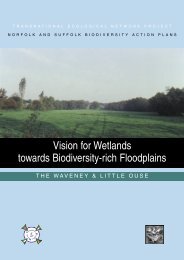

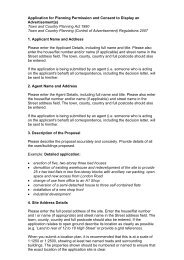
![Brown bin calendar - week 2 [PDF] - South Norfolk Council](https://img.yumpu.com/49352110/1/184x260/brown-bin-calendar-week-2-pdf-south-norfolk-council.jpg?quality=85)
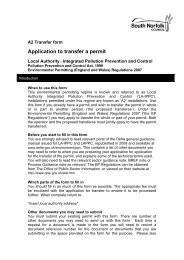

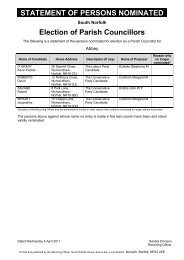
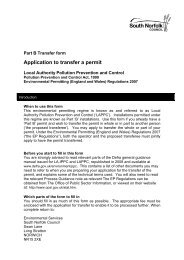
![Link magazine, Spring 2008 [PDF, 4,450k] - South Norfolk Council](https://img.yumpu.com/43994858/1/184x260/link-magazine-spring-2008-pdf-4450k-south-norfolk-council.jpg?quality=85)
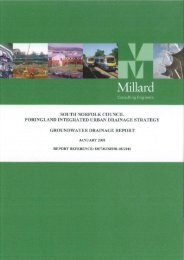
![South Norfolk Council Volunteering Opportunities [PDF]](https://img.yumpu.com/42079564/1/184x260/south-norfolk-council-volunteering-opportunities-pdf.jpg?quality=85)
![Tiffey Valley Guide [PDF, 1,450k] - South Norfolk Council](https://img.yumpu.com/41615145/1/124x260/tiffey-valley-guide-pdf-1450k-south-norfolk-council.jpg?quality=85)
![Queen's Diamond Jubilee Fund [PDF] - South Norfolk Council](https://img.yumpu.com/41088331/1/184x260/queens-diamond-jubilee-fund-pdf-south-norfolk-council.jpg?quality=85)
